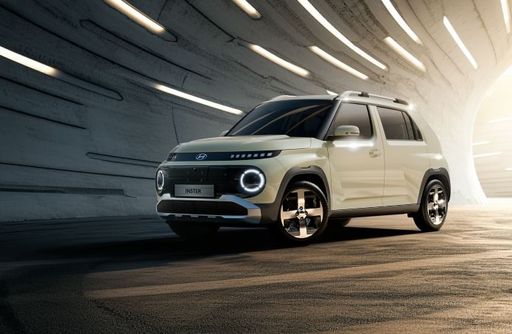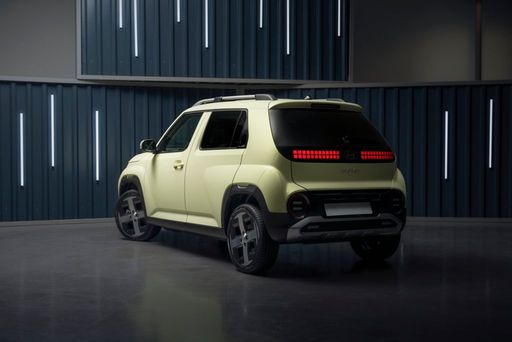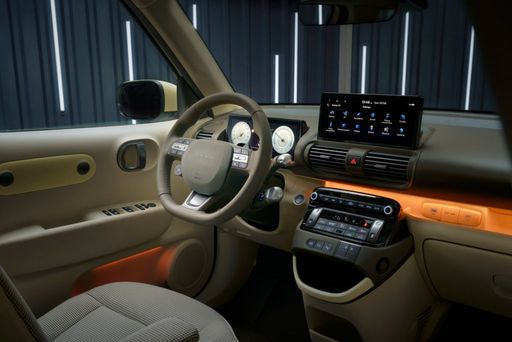Hyundai Inster vs Renault R4 – Ytelse, rekkevidde og forbruk sammenlignet
Enten du ser etter en bil til hverdagsbruk, familie eller lange turer – her ser du forskjellene.
Finn ut om Hyundai Inster eller Renault R4 passer best til din livsstil.
Comparing the Hyundai Inster and Renault R4: The Future of Electric SUVs
In the fast-evolving world of electric vehicles, choosing the right compact SUV can be a daunting task. Two prominent contenders in the market are the Hyundai Inster and the Renault R4. Both vehicles, set to make significant waves in 2025, offer a range of features and innovations. In this article, we delve into the technical details and compare their offerings to help steer potential buyers in the right direction.
Design and Exterior - Compact Yet Stylish
Both the Hyundai Inster and the Renault R4 exhibit a modern and sleek SUV design, characterized by their aerodynamic lines and practical dimensions. The Inster measures around 3845mm in length and 1610mm in width, while the R4 is slightly larger, stretching to 4144mm in length and 1808mm in width. Despite their compact frames, these SUVs offer a commanding presence on the road. The Hyundai's height fluctuates between 1575mm to 1610mm, slightly taller than the Renault's consistent height of 1552mm.
Power and Performance - Speed Meets Efficiency
Under the hood, both vehicles boast electric powertrains designed for efficiency and performance. The Hyundai Inster features power outputs of 97 to 115 HP (71 to 85 kW), with a maximum speed ranging from 140 to 150 km/h. It accelerates from 0 to 100 km/h in 10.6 to 11.7 seconds. The Renault R4, however, is more powerful with 122 to 150 HP (90 to 110 kW), offering robust acceleration from 0 to 100 km/h in a brisk 8.2 to 9.2 seconds, and a top speed of 150 km/h. The R4's torque ranges from 225 to 245 Nm, whereas the Hyundai offers 147 Nm, indicating a distinct difference in performance feel.
Electric Range and Efficiency - Going the Extra Mile
For eco-conscious consumers, electric range and energy consumption are crucial considerations. The Hyundai Inster offers a range between 327 and 370 km depending on the variant, consuming between 14.3 and 15.1 kWh per 100 km. Meanwhile, the Renault R4 provides a longer range of 322 to 409 km, equipped with battery capacities between 40 and 52 kWh. Both vehicles ensure zero CO2 emissions, with the R4 edging out slightly in terms of range extension.
Interior Comfort and Space - Tailored for Families
The interior space and seating arrangement are pivotal for families and commuters needing versatility. The Hyundai Inster accommodates four passengers, with a trunk capacity ranging from 238 to 280 liters. It offers a stylish yet functional layout, aligning with its modern electric identity. On the other hand, the Renault R4 seats five passengers and boasts a generous trunk capacity of 420 liters, promising more room for those occasional family road trips or grocery runs.
Innovation and Tech - An Eye on the Future
Both the Hyundai Inster and Renault R4 come equipped with cutting-edge technologies enhancing comfort and safety. Automatic transmissions with front-wheel drive underline their user-friendly appeal. Models are designed for the eco-minded with CO2 Efficiency Class A ratings, ensuring environmentally responsible driving. These vehicles promise an intuitive driving experience, blending innovation with practicality.
Verdict - Picking the Right Electric SUV
Choosing between the Hyundai Inster and Renault R4 depends on individual needs and preferences. The Hyundai Inster shines with its compact design and efficiency, ideal for those prioritizing agility and daily commutes. Conversely, the Renault R4 impresses with superior power, enhanced seating capacity, and a more extensive range, making it a suitable option for families and long-distance travelers. Both vehicles represent the forefront of electric SUV innovation, providing exceptional alternatives for the modern driver.
As we move towards greener modes of transportation, selecting the right electric SUV can make a substantial difference, not only in personal mobility but also in contributing to a sustainable future. Whether you lean towards Hyundai’s compact efficiency or Renault’s spacious power, the future of electric driving is indeed promising.
Her blir det konkret: De tekniske forskjellene i detalj
Kostnader og forbruk: Når det gjelder økonomi i bruk, ser vi interessante forskjeller mellom de to modellene.
Hyundai Inster har et tydelig prisfortrinn – den starter på 23900 €, mens Renault R4 koster 29400 €. Forskjellen er omtrent 5500 €.
I strømforbruk har Renault R4 fordelen: Med 14.20 kWh per 100 km er den knapt merkbar mer effektiv enn Hyundai Inster, som bruker 14.30 kWh. Forskjellen er omtrent 0.10 kWh.
Når det gjelder rekkevidde, presterer Renault R4 lett bedre: Den klarer opptil 409 km, altså omtrent 39 km mer enn Hyundai Inster.
Motor og ytelse: Under panseret ser man hvilken modell som har den mer sportslige karakteren – og hvem som akselererer best.
Når det gjelder motoreffekt, har Renault R4 et påfallende overtak – 150 hk mot 115 hk. Det tilsvarer en forskjell på omtrent 35 hk hk.
I akselerasjon fra 0 til 100 km/t er Renault R4 påfallende raskere – 8.20 s mot 10.60 s. Forskjellen er omtrent 2.40 s.
Det er ingen forskjell i toppfart – begge når 150 km/h.
Også når det gjelder dreiemoment, er det forskjeller: Renault R4 drar tydelig kraftigere med 245 Nm mot 147 Nm. Forskjellen er omtrent 98 Nm.
Plass og praktiske egenskaper: Utover rå ytelse teller hverdagskomfort mest. Her avgjøres det hvilken bil som er mest praktisk og allsidig.
Seter: Renault R4 tilbyr i liten grad flere sitteplasser – 5 mot 4.
Når det gjelder egenvekt, er Hyundai Inster knapt merkbar lettere – 1380 kg mot 1485 kg. Forskjellen er omtrent 105 kg.
Når det gjelder bagasjeromsplass, tilbyr Renault R4 påfallende mer plass – 420 L mot 280 L. Forskjellen er omtrent 140 L.
Ved maksimal lastekapasitet scorer Renault R4 påfallende bedre – opptil 1405 L, omtrent 346 L mer enn Hyundai Inster.
Også når det gjelder nyttelast, vinner Renault R4 i liten grad – 443 kg mot 357 kg. Forskjellen er omtrent 86 kg.
Vår konklusjon: Renault R4 viser seg å være vinner duellen klart og blir dermed vår DriveDuel Champion!
I denne sammenligningen fremstår Renault R4 som den mer komplette allrounderen.
Hyundai Inster
The Inster has quickly captured the attention of automotive enthusiasts with its striking design and dynamic performance. This model seamlessly blends advanced technology with comfort, making it an ideal choice for both daily commutes and adventurous road trips. With its spacious interior and innovative features, the Inster promises an exhilarating driving experience that doesn’t compromise on practicality.
detaljer @ hyundai.news
@ hyundai.news
 @ hyundai.news
@ hyundai.news
 @ hyundai.news
@ hyundai.news
Renault R4
The Renault R4, affectionately known as the "R4," is a quintessential symbol of French automotive simplicity and practicality. This classic compact car, originally introduced in the early 1960s, won over numerous enthusiasts with its versatile design and dependable performance. Its no-frills charm and robust build made it a beloved choice for rural drivers and city dwellers alike, cementing its status as an iconic piece of automotive history.
detaljer

|
|
|
|
|
Kostnader og forbruk |
|
|---|---|
|
Pris
23900 - 30100 €
|
Pris
29400 - 36400 €
|
|
Forbruk L/100km
-
|
Forbruk L/100km
-
|
|
Forbruk kWh/100km
14.3 - 15.1 kWh
|
Forbruk kWh/100km
14.2 - 15.1 kWh
|
|
Elektrisk rekkevidde
327 - 370 km
|
Elektrisk rekkevidde
308 - 409 km
|
|
Batterikapasitet
42 - 49 kWh
|
Batterikapasitet
40 - 52 kWh
|
|
co2
0 g/km
|
co2
0 g/km
|
|
Tankkapasitet
-
|
Tankkapasitet
-
|
Mål og karosseri |
|
|---|---|
|
Karosseri
SUV
|
Karosseri
SUV
|
|
Seter
4
|
Seter
5
|
|
Dører
5
|
Dører
5
|
|
Egenvekt
1380 - 1433 kg
|
Egenvekt
1485 - 1537 kg
|
|
Bagasjerom
238 - 280 L
|
Bagasjerom
420 L
|
|
Lengde
3825 - 3845 mm
|
Lengde
4144 mm
|
|
Bredde
1610 mm
|
Bredde
1808 mm
|
|
Høyde
1575 - 1610 mm
|
Høyde
1552 mm
|
|
Maks bagasjerom
1059 L
|
Maks bagasjerom
1405 L
|
|
Nyttelast
317 - 357 kg
|
Nyttelast
410 - 443 kg
|
Motor og ytelse |
|
|---|---|
|
Motortype
Elektrisk
|
Motortype
Elektrisk
|
|
Girkasse
Automat
|
Girkasse
Automat
|
|
Gir detalj
Reduksjonsgir
|
Gir detalj
Reduksjonsgir
|
|
Drivtype
Forhjulsdrift
|
Drivtype
Forhjulsdrift
|
|
Effekt hk
97 - 115 hk
|
Effekt hk
122 - 150 hk
|
|
Akselerasjon 0-100km/t
10.6 - 11.7 s
|
Akselerasjon 0-100km/t
8.2 - 9.2 s
|
|
Maks hastighet
140 - 150 km/h
|
Maks hastighet
150 km/h
|
|
Dreiemoment
147 Nm
|
Dreiemoment
225 - 245 Nm
|
|
Antall sylindre
-
|
Antall sylindre
-
|
|
Effekt kW
71 - 85 kW
|
Effekt kW
90 - 110 kW
|
|
Slagvolum
-
|
Slagvolum
-
|
Generelt |
|
|---|---|
|
Modellår
2025
|
Modellår
2025
|
|
CO2-effektivitetsklasse
A
|
CO2-effektivitetsklasse
A
|
|
Merke
Hyundai
|
Merke
Renault
|
Hvilke drivverksalternativer tilbyr Hyundai Inster?
Finnes som Forhjulsdrift.
De viste prisene og dataene er estimater basert på tyske listepriser og kan variere avhengig av land. Denne informasjonen er ikke juridisk bindende.
